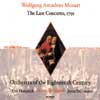Mozart Last Concerto (The)
A programme dedicated to Mozart’s love-affair with the clarinet family
View record and artist detailsRecord and Artist Details
Composer or Director: Wolfgang Amadeus Mozart
Genre:
Orchestral
Label: Glossa
Magazine Review Date: 2/2003
Media Format: CD or Download
Media Runtime: 60
Mastering:
Stereo
DDD
Catalogue Number: GCD921107

Tracks:
| Composition | Artist Credit |
|---|---|
| Concerto for Clarinet and Orchestra |
Wolfgang Amadeus Mozart, Composer
Eric Hoeprich, Basset clarinet Frans Brüggen, Conductor Orchestra of the Eighteenth Century Wolfgang Amadeus Mozart, Composer |
| (La) Clemenza di Tito, Movement: Overture |
Wolfgang Amadeus Mozart, Composer
Frans Brüggen, Conductor Orchestra of the Eighteenth Century Wolfgang Amadeus Mozart, Composer |
| (La) Clemenza di Tito, Movement: Parto, parto, ma tu, ben mio |
Wolfgang Amadeus Mozart, Composer
Eric Hoeprich, Basset clarinet Frans Brüggen, Conductor Joyce Di Donato, Mezzo soprano Orchestra of the Eighteenth Century Wolfgang Amadeus Mozart, Composer |
| (La) Clemenza di Tito, Movement: ~ |
Wolfgang Amadeus Mozart, Composer
Eric Hoeprich, Basset horn Frans Brüggen, Conductor Joyce Di Donato, Mezzo soprano Orchestra of the Eighteenth Century Wolfgang Amadeus Mozart, Composer |
| Adagio |
Wolfgang Amadeus Mozart, Composer
Annette Thomas, Basset horn Eric Hoeprich, Clarinet Guy van Waas, Basset horn Lorenzo Coppola, Basset horn Toni Salar-Verdu, Clarinet Wolfgang Amadeus Mozart, Composer |
| Maurerische Trauermusik, "Masonic Funeral Music" |
Wolfgang Amadeus Mozart, Composer
Frans Brüggen, Conductor Orchestra of the Eighteenth Century Wolfgang Amadeus Mozart, Composer |
Author: Stanley Sadie
This slightly arbitrary collection of pieces, gathered together under the title ‘The Last Concerto’, places Mozart’s Clarinet Concerto (his last concerto, of course) in a context of his clarinet music: two arias with obbligatos, two masonic pieces, with the overture to La clemenza di Tito apparently thrown in as a makeweight. Although Frans Brüggen’s direction of the tuttis is often a bit affected – odd little pauses, slow-downs and diminuendi that really aren’t consistent with the style – the performance of the Concerto as a whole is persuasive. Eric Hoeprich is a fine musician, deeply knowledgeable about his instrument (he made his own basset clarinets used here), sensitive and unassuming. The tone is soft and warm in the upper register, distinct and nicely reedy lower down, with a throaty, resonant lower ‘basset’ extension. He always seems to have plenty of time to shape the music. His articulation is beautifully clear, light and even in the rapid music. Here and there, where Mozart clearly invites it (and occasionally where he doesn’t), Hoeprich adds touches of ornamentation.
He shines too in the two arias where Mozart supplied obbligatos for his friend Anton Stadler. Hoeprich and Joyce DiDonato’s interchanges in the opening Adagio of ‘Parto, parto’ are beautifully done; in the Allegro Brüggen again plays (as it were) slow and loose with the tempo, but the soloists make the final section highly dramatic and indeed exciting. DiDonato has a strong line and plenty of mettle in her voice. Switching from primo uomo to prima donna, she takes the opening section of ‘Non più di fiori’ unusually slowly, but it is very telling at this tempo. Hoeprich’s bassethorn is often very faint in this aria.
Of the other instrumental items, the Adagio, K411 might have profited from a slightly slower tempo: it’s a grave, noble piece and though admirably played doesn’t quite get full value. But the sound of the ensemble is beguilingly rich and reedy. The textures of the Masonic Funeral Music are strongly characterised but the overture seems to me rather too selfconsciously done.
He shines too in the two arias where Mozart supplied obbligatos for his friend Anton Stadler. Hoeprich and Joyce DiDonato’s interchanges in the opening Adagio of ‘Parto, parto’ are beautifully done; in the Allegro Brüggen again plays (as it were) slow and loose with the tempo, but the soloists make the final section highly dramatic and indeed exciting. DiDonato has a strong line and plenty of mettle in her voice. Switching from primo uomo to prima donna, she takes the opening section of ‘Non più di fiori’ unusually slowly, but it is very telling at this tempo. Hoeprich’s bassethorn is often very faint in this aria.
Of the other instrumental items, the Adagio, K411 might have profited from a slightly slower tempo: it’s a grave, noble piece and though admirably played doesn’t quite get full value. But the sound of the ensemble is beguilingly rich and reedy. The textures of the Masonic Funeral Music are strongly characterised but the overture seems to me rather too selfconsciously done.
Discover the world's largest classical music catalogue with Presto Music.

Gramophone Digital Club
- Digital Edition
- Digital Archive
- Reviews Database
- Full website access
From £8.75 / month
Subscribe
Gramophone Full Club
- Print Edition
- Digital Edition
- Digital Archive
- Reviews Database
- Full website access
From £11.00 / month
Subscribe
If you are a library, university or other organisation that would be interested in an institutional subscription to Gramophone please click here for further information.




